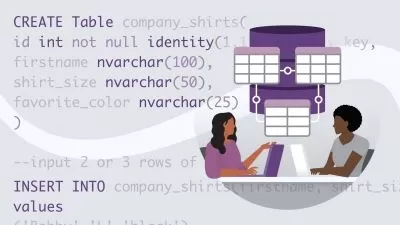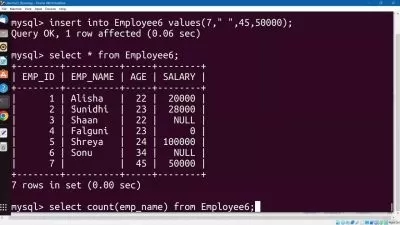Basic SQL SELECT
Eric Manske
2:01:38
Description
Using SQL (Structured Query Language) to select data from a database
What You'll Learn?
- Understand the logic of databases and succeed at pulling data from them
- Be able to answer the question, "What is SQL?" with a few different answers
- Know the basics of the six standard SQL SELECT statement clauses
- Understand a couple different ways to pull together data from more than one data set
- Construct well-formed SQL SELECT statements that allow others (and you in the future) to understand, at a glance, the business request
- Know how to pursue further SQL instruction and how to research your SQL questions
Who is this for?
More details
DescriptionThe tools of business continue to change and grow. Long ago, paper and pencil replaced rote memory and more recently were themselves replaced by computers. Analysts used to work out calculations on calculators, then switched to spreadsheet applications, like Excel. Understanding SQL used to be a skill reserved for IT personnel; now, SQL is becoming an indispensable analytical tool in the modern workplace. Just like spreadsheets were once a tool known only to specialists but are now ubiquitous in the workplace, likewise SQL is beginning to become more accessible throughout organizations.
This course focuses on the SELECT statement in SQL so stays squarely in the realm of Data Query Language (DQL) commands. Although this focus may sound limiting, understanding the SELECT statement is essential for many of the other commands, since typically the data will need to be selected first before doing something else with it. As well, many of the standard and exotic commands and functions can be easily presented with a SELECT statement, and mastery of this beginning set will prepare people for further explorations into SQL.
I learned everything IÂ know about SQLÂ on the job, and so can you. After teaching for 10 years, IÂ was pulled into IT at my first corporate position and have used SQLÂ in every role since then. I know what it is like to learn a keyword for the first time, to start exploring its uses, to be shown tricks and techniques using it by others, and to eventually gain a deeper understanding of why it works the way it does. I have trained many others in SQL in companies large and small, including some Fortune 50 companies. I have compiled my experiences and curated from those lessons what I believe to be the important initial steps to share with you. (Those of you from my past training sessions will likely recognize parts of these lessons!) I trust you will take this knowledge, and Spirit willing, share it with others.
So, without further ado, let's begin. Please click on the first lecture in section 1, the starting point to work your way through this course.
Who this course is for:
- Anyone who has heard of SQL and wants to know a bit about what it is
- Businesspeople who have been given SQL statements and want to know more about what they have been given
- Beginners with SQL (all platforms)
The tools of business continue to change and grow. Long ago, paper and pencil replaced rote memory and more recently were themselves replaced by computers. Analysts used to work out calculations on calculators, then switched to spreadsheet applications, like Excel. Understanding SQL used to be a skill reserved for IT personnel; now, SQL is becoming an indispensable analytical tool in the modern workplace. Just like spreadsheets were once a tool known only to specialists but are now ubiquitous in the workplace, likewise SQL is beginning to become more accessible throughout organizations.
This course focuses on the SELECT statement in SQL so stays squarely in the realm of Data Query Language (DQL) commands. Although this focus may sound limiting, understanding the SELECT statement is essential for many of the other commands, since typically the data will need to be selected first before doing something else with it. As well, many of the standard and exotic commands and functions can be easily presented with a SELECT statement, and mastery of this beginning set will prepare people for further explorations into SQL.
I learned everything IÂ know about SQLÂ on the job, and so can you. After teaching for 10 years, IÂ was pulled into IT at my first corporate position and have used SQLÂ in every role since then. I know what it is like to learn a keyword for the first time, to start exploring its uses, to be shown tricks and techniques using it by others, and to eventually gain a deeper understanding of why it works the way it does. I have trained many others in SQL in companies large and small, including some Fortune 50 companies. I have compiled my experiences and curated from those lessons what I believe to be the important initial steps to share with you. (Those of you from my past training sessions will likely recognize parts of these lessons!) I trust you will take this knowledge, and Spirit willing, share it with others.
So, without further ado, let's begin. Please click on the first lecture in section 1, the starting point to work your way through this course.
Who this course is for:
- Anyone who has heard of SQL and wants to know a bit about what it is
- Businesspeople who have been given SQL statements and want to know more about what they have been given
- Beginners with SQL (all platforms)
User Reviews
Rating
Eric Manske
Instructor's Courses
Udemy
View courses Udemy- language english
- Training sessions 18
- duration 2:01:38
- Release Date 2023/03/29










